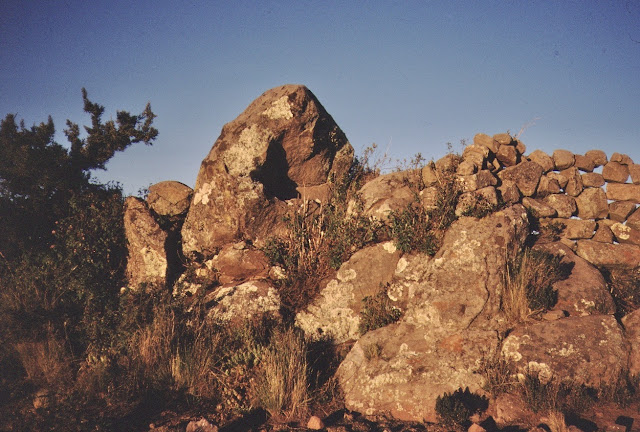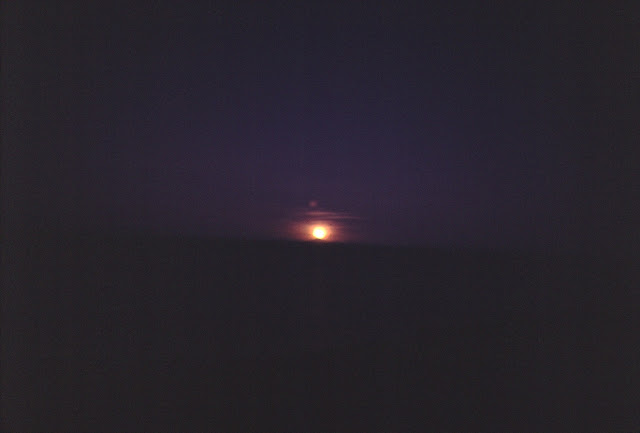Taquile Island, Peru June 10-12, 1979
Taquile Island, Lake Titicaca, Peru: another one of those places that words cannot describe….
We took a slow boat into the centre of Lake Titicaca to Taquile Island. The boat and the engine were both old and tired, so it took us three hours. But as far as the Lake people are concerned, that’s fast. Six years ago, traveling in a traditional rush-hulled sail boat, it would have taken at least a whole day, and maybe several days, if the weather was uncooperative, to get to Taquile. Once we got there we faced a physically challenging climb up a beautiful but very steep stone stairway to the ridge-top of the island. Between the altitude, the weight of our packs, the mid-day heat and the size of the steps, some of which were very high, it took every ounce of energy, determination and grit I had.
As we walked up the incredible, endless, stone stairway we were greeted by young lads, quietly and patiently tending little flocks of sheep. All of them were standing, and all of them were knitting, using four very small needles, and red and white threads. They were making ‘Santa’ hats – toques with long tails and pom-poms at the end. The boys were all dressed the same: black coarse-woven wool pants, often rolled up at the bottom to reveal a cream-coloured lining of the same coarse-woven wool. (Apparently the wool is llama, imported from Puno, although some of it may be sheep.) They all wore a shirt of the same cream-coloured material, with long, full sleeves, gathered tightly at the cuffs. Some boys sported wide cummerbunds of more finely woven wool, some mostly red with bird and fish designs, and some mostly white with dark blue pin-stripes. The white bands were longer than the red ones, and were wrapped several times around the boys’ waists. Perhaps they served another purpose…. . Overtop the shirt, they wore a black and white waistcoat, quite small and open at the front. The back of the waistcoat was black; the front was white. And if this beautiful costume weren’t in itself enough, they all wore the very, very tightly and finely knit red and white Santa hats on their heads. The broad crowns of the hats were primarily red, with intricate designs of coloured animals, birds and geometric designs; the floppy top part of the hat was very white, not creamy, and tapered to a point. The end of the hat, a red pom-pom, reached the ear, or lower. Best of all, all of the boys were wearing big smiles, exposing beautiful white, strong, and even teeth. These are healthy-looking lads. They greeted us with friendly words as we made our way, slowly, up the long stone staircase.
When I finally reached the top of the staircase I cheered – “yippie!” The boys laughed. Likely they could have run up it without turning a hair.
At the top of the stairs one of the boys took our names and assigned us to a house where we would stay with a family. There are no hotels or inns or pensions on the island. There were a couple of young girls standing beside this boy. They were dressed in black coarse woven skirts with red underskirts, white, red or black shirts, much like the ones the boys wore, and long black shawls which covered both head and face, a protection against the sun. One of these girls lead us to her – and our – home. Our new digs were spartan: a mud-adobe, windowless, thatched-roofed, one-room casita, with a door opening onto a tiny courtyard, on the other side of which was the family’s casita, identical to ours, with the exception that the entire family lived, slept and cooked there. Inside our casita were two wide bench beds, formed from the adobe of the walls, and covered with reed mats and one blanket. The walls around the beds were also covered with reeds, for warmth. There was a stone table between the beds – a large flat slab set on top of two smaller stones – almost prehistoric in its simplicity, but austerely beautiful. For light, a single candle. We noticed that one of the beds had a couple of back-packs on it already. It turned out we'd be sharing this little space with a French couple, Richard and Jacqueline. We both hoped they weren't smokers....
The young girl who had led us there, and a brother who appeared when we got there, busied themselves with ‘cleaning’ the hut – wiping the table, and picking up cigarette butts apparently left by previous guests (how could they?). A younger brother, perhaps 6 or 7, looked on with huge round eyes. He was dressed in rags, a dirty cream-coloured shirt-dress (a hand-me-down from an older boy….?), now too small and too ripped to serve any purpose at all, not even covering his thighs, and an even dirtier grey sweater. Once she’d finished cleaning the hut, the girl returned to her main occupation – spinning wool.
Once we got settled we headed out to explore the island. It’s an island of rock and grass, low shrub and small, interspersed wheat fields. And a masterpiece of terracing – almost every inch of it sectioned off by terraces made of big rocks, at times piled rather precariously, one on top of another. Everywhere also are stone ‘fences’ and walls – these are more open, windowed or latticed – so more friendly than imposing, like the solid Incan walls. But these fences are designed primarily to keep the many sheep and few cows out of the fields, not to repel invaders or stop trespassers. The mostly dirt pathways are lined with little stones, sending a clear message: stay on the paths!
I could see no roads, no cars, and no bicycles. It was so quiet – just the chatter of little birds and the far-away sounds of kids playing. On top of every little hillock, and at times right beside one of the pathways, are stone cairns, some small, just a couple of feet high, and some very large, almost like little houses. Some are topped with a cross, some made into a form like a seat or throne. Some of the stone constellations looked like people or animals, and some of the stones were carved.
We walked down to the village, about a half-hour from our casita, and down the opposite side of the island from where we’d landed. This side was more gently sloping, with fewer, and less steep stairways. So an easy stroll, both coming and going. The village was a very small cluster of adobe and wood buildings, ringing a dusty plaza and overlooking the lake and the far-away snow-peaked mountains of Bolivia. There were a couple of small ‘restaurants’ and an artesenial shop in town, but not much else. I was glad it was still so unspoiled by tourism. There were very few tourists here – we saw perhaps 6 or 8 while we were in town, and a few more as we walked around the island.
My two days on Taquile were spent roaming the island, walking the stone paths, drinking in the landscape, ‘observing’ the people and their daily lives, and sometimes interacting with those who were both brave enough, and able to speak enough Spanish (they speak Quechua), to converse with me. I am taken, inspired, by the overwhelming simplicity of life here. There are only 400 permanent residents on the island. There very few young people here – almost none between the ages of 12 and 20. Also very few middle-aged people. Why? Perhaps the youths are in school in Puno, and board with families there. And perhaps some of the middle-aged people work there as well.
The island is incredibly quiet – there are no roads, no cars, and no electricity. There are no beasts of burden here, no donkeys or llamas. All work is done by people, mostly by hand. The loudest noise is the shriek of a startled bird, or the twangy music from a transistor radio, carried on a shoulder by virtually all of the knitting shepherds. The people themselves are also very quiet, seldom speaking above a whisper. Men, women and children are constantly working. In addition to doing all the household chores, the women and girls spin wool if they are walking somewhere. Young men and boys tend sheep, knitting constantly; their hands are never still. Men old and young, and some women and girls work the terraces by hand, literally with their bare hands, or sometimes hoes and shovels. They grow wheat, some potatoes, and dwarf corn. No fruit, no vegetables. They collect water from communal wells, water sweeter than the lake water, but in much shorter supply, partly due to the fact that it is brought up from the depths by hand. They collect firewood from whatever can be found – twigs and branches from the sparse shrubbery; eucalyptus here are few, and spindly.
I am also taken by the harshness of so many of the people’s lives here. A young girl picking beans in a field, so thin and weak she could barely walk. A young boy, his legs apparently useless, dragging himself with arms and elbows, from the door of his house out towards the family’s fields, sing-talking to himself. Raggedy children, dirty-faced with filthy hands, and running noses. The sea of outreaching hands when I opened a small packet of biscuits, the packet gone within seconds. The little boy at our ‘house’ overjoyed with a little plastic whistle on a string that I gave him, learning first how to make it ‘sing’, then whistling, whistling, whistling everywhere he went.
At one point as I was sitting in the only eatery in town I ended up getting involved in a sad and unfortunate episode which seemed uncharacteristic and out-of-place on the island. A little boy was returning from the lake with a string of fish he’d caught. They were mostly small, but there was one big one which he proudly showed to the restaurant owners. They promptly took it from him, laughing. He laughed with them, but his laughter turned quickly to tears when they made it clear they had no intention of giving it back to him. This was his family’s supper – gone. I was moved to intercede, and ended up in quite a long argument with the restaurant owners, who eventually, possibly out of embarrassment more than shame, gave the boy back his fish. The look the boy gave me, as he left, was pitifully grateful.
All told, an incredible place to visit – the most remarkable society I’ve seen yet, in some ways reminiscent of traditional Greek islands, especially in terms of the stone terracing, the stair-streets, the black-draped women, the silence and the sun. In some ways reminiscent of Bedouins, the shy silence of the people, and their beautiful smiling faces and eyes… .




















Comments
Post a Comment